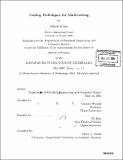Coding techniques for multicasting
Author(s)
Khisti, Ashish, 1979-
DownloadFull printable version (3.546Mb)
Alternative title
Coding techniques for multicasting in wireless networks
Other Contributors
Massachusetts Institute of Technology. Dept. of Electrical Engineering and Computer Science.
Advisor
Gregory Wornell and Uri Erez.
Terms of use
Metadata
Show full item recordAbstract
We study some fundamental limits of multicasting in wireless systems and propose practical architectures that perform close to these limits. In Chapter 2, we study the scenario in which one transmitter with multiple antennas distributes a common message to a large number of users. For a system with a fixed number (L) of transmit antennas, we show that, as the number of users (K) becomes large, the rate of the worst user decreases as O(K-(1/L)). Thus having multiple antennas provides significant gains in the performance of multicasting system with slow fading. We propose a robust architecture for multicasting over block fading channels, using rateless erasure codes at the application layer. This architecture provides new insights into the cross layer interaction between the physical layer and the application layer. For systems with rich time diversity, we observe that it is better to exploit the time diversity using erasure codes at the application layer rather than be conservative and aim for high reliability at the physical layer. It is known that the spatial diversity gains are not significantly high in systems with rich time diversity. We take a step further and show that to realize these marginal gains one has to operate very close to the optimal operating point. Next, we study the problem of multicasting to multiple groups with a multiple antenna transmitter. The solution to this problem motivates us to study a multiuser generalization of the dirty paper coding problem. This generalization is interesting in its own right and is studied in detail in Chapter 3. The scenario we study is that of one sender and many receivers, all interested in a common message. There is additive interference on the channel of each receiver, which is known only to the sender. (cont.) The sender has to encode the message in such the way that it is simultaneously 'good' to all the receivers. This scenario is a non-trivial generalization of the dirty paper coding result, since it requires that the sender deal with multiple interferences simultaneously. We prove a capacity theorem for the special case of two user binary channel and derive achievable rates for many other channel modes including the Gaussian channel and the memory with defects model. Our results are rather pessimistic since the value of side information diminishes as the number of users increase.
Description
Thesis (S.M.)--Massachusetts Institute of Technology, Dept. of Electrical Engineering and Computer Science, 2004. Includes bibliographical references (leaves 74-77).
Date issued
2004Department
Massachusetts Institute of Technology. Department of Electrical Engineering and Computer SciencePublisher
Massachusetts Institute of Technology
Keywords
Electrical Engineering and Computer Science.